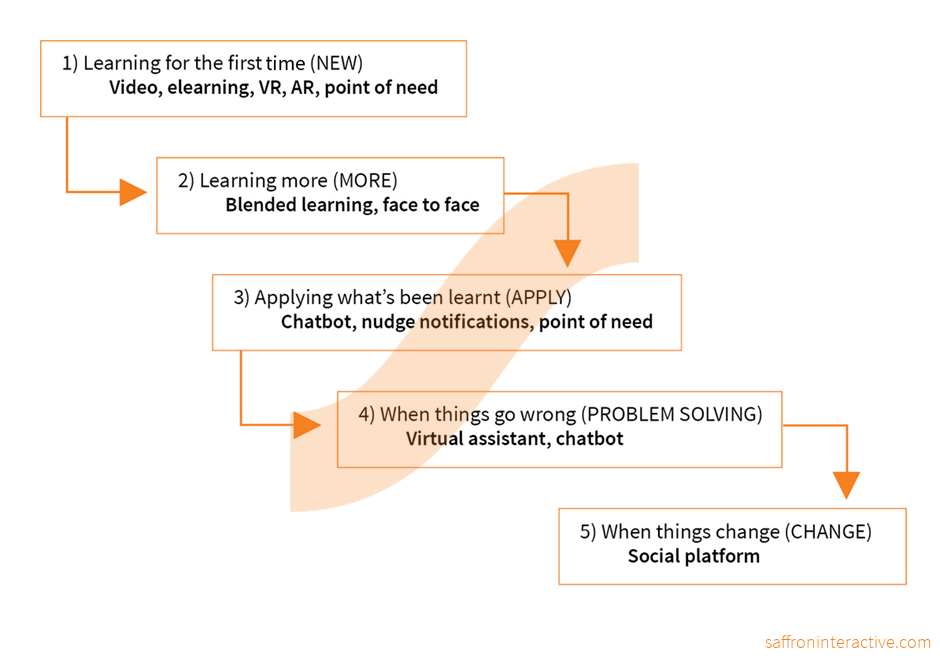The world looks very different to how it did 20 years ago. Take car manufacturing, for example. With the onset of robotics, hardware is rapidly pushing jobs away from the assembly line and into knowledge-based roles that specialise in optimising the way we use new technology. But car manufacturing, as well as nearly every other industry, is facing a big problem. There are simply not enough people with the right skills for these new roles.
It’s called the skills gap, and it’s getting wider.
In a study last year, the Open University Business Barometer found that 90% of employers are struggling to find workers with the required skills for their organisation. How much of a problem is that? Well, they ended up spending £6.3 billion on trying to plug that skills gap themselves.
This is a worrying figure for both our educational systems and our learning and development departments. At a fundamental level, universities are not producing enough people with skills relevant to a modern working world, and companies are failing to develop these skills in their employees.
Moving targets
Because of the fluid nature of the digital world, and the pace at which innovation can now occur, one of the defining characteristics of the new working landscape is the high speed of change.
The World Economic Forum estimates that as many as 65% of children entering primary school today will enter the world of work with job titles that do not currently exist and that organisations should prepare for ‘wholesale re-skilling of existing workforces throughout their lifecycle’.
Being able to constantly adapt will be the key to survival more than ever, and the speed at which organisations can up-skill their workforce is an area where competitive advantage can be gained.
So how are large organisations going to maintain a stable, high quality workforce in a rapidly moving world – one that will allow them to remain competitive and grow?
One thing that’s for sure is that it will require a change in attitudes and the ambition and courage to embrace new solutions.
For the past millennia, educational systems have developed around the physical necessity for a teacher to be in the same room as a student. This helped form the paradigm through which learning is often still structured, being that a learner sits in a classroom, gains knowledge, and then goes out and applies this understanding in the world of work.
Even modern digital learning has failed to move away from this model significantly, with elearning courses simply replacing the classroom as a venue. However, in a world where the breadth of human knowledge is a short search away, that didactic setting is completely inadequate.
At Saffron, we’re a big fan of Mosher and Gottfredson’s 5 moments of need as a knowledge acquisition model. This points the way to a much more holistic approach, whereby the learner learns both autonomously and performatively, through the following five moments:
- Learning for the first time
- Learning more
- Applying what’s been learnt
- When things go wrong
- When things change
Organisations tend to provide solutions to the first two moments of need, but neglect the other three because historically it has taken up too many resources to provide effective support at these moments. However, this is not the case and learning needs to be put into action for effective learning transfer.
The first two stages have become overly saturated with traditional methods. The key thing in the knowledge economy is that new processes, procedures and new systems even when learning for the first time can be adopted quicker and therefore accelerated performance can be achieved with point-of-need tools.
The same advancements in technology mean there’s now no excuse not to also cater for when things go wrong or when they change. After all, you learn from your mistakes. So why not enable people to fail in a safe environment and strive for higher levels of efficiency and productivity?
Through enabling people to learn more effectively on the job, we free up the time and energy that would be spent stumbling through new software systems into focusing on upskilling and creativity, minimising the negative impact of the skills gap to create value for themselves and the organisation they are a part of.
Performance support tools
Have you ever been stuck and asked Google a question? If so, then you were using it as a performance support tool. There is no doubt that Google is useful, but having to leave what you are doing and venture onto the big bad web to get a small piece of information is inefficient and, in terms of a professional environment, does not guarantee the quality of the learning content.
The new generation of digital performance support tools allow organisations to curate the content and provide assistance to their employees at the point-of-need. That means employees don’t have to turn to Google when they’re stuck, or ask a time poor manager, or even just struggle through the headache of trying to recall information learned six months ago in a class room. They get the answer they need immediately.
This helps streamline the ‘learning-on-the-job’ process and supercharges performance. So only the knowledge that the learner actually needs in their day-to-day workflow is provided. It helps create that all important commodity – time – to allow individuals to fine-tune the skills and behaviours they need to adopt.
Not only that, but performance support tools can collect data and insights on where an individual, and therefore the workforce as a collective, is struggling. This enables laser-guided strategic insights to help improve the rest of the learning offering.
Performance in practice
So how does that look in terms of practical solutions? Well, if you go back to the moments of need, you can begin to populate these with appropriate learning interventions. Realistically, most tools will cover a multitude of needs, but it helps to consider them in this way:

There are many approaches to targeting these needs, whether a chatbot, a mobile app or a virtual assistant. Saffron eaSe, for example, our own point-of-need performance support tool, sits as a sub-window on the desktop and moves with the learner through their workflow, providing context-relevant, internally-sourced information both on and offline.
The challenge of closing the skills gap is daunting but not impossible. To achieve it, a change in attitude is required: from education being something you ‘complete’ and then apply, to a continuous, lifelong process. In addition, performance support tools like eaSe can play an important part in being able to learn effectively on the job so that workforces are able to keep up with the speed of technological development.
With its ability to create data-driven insights, tools like eaSe are adaptive by design and can become the backbone of a modern learning strategy that ensures an organisation’s workforce remains relevant in a rapidly changing world.
Tell us what you are doing to beat the skills gap in your organisation by commenting below.





